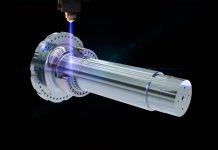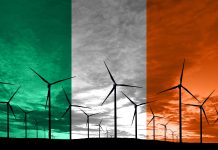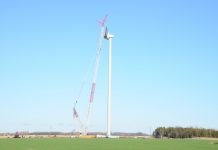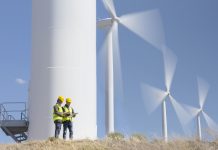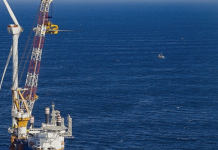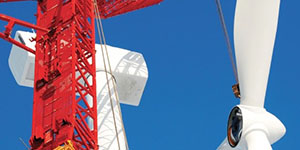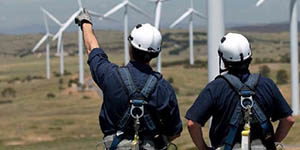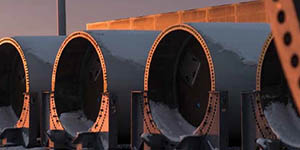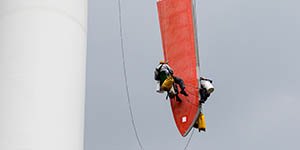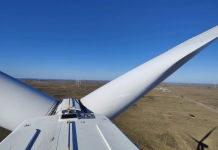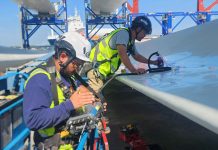The internal workings of a wind turbine must be protected from the often-harsh environments a turbine is subjected to in its lifetime. Manufacturing that cover needs to be made of the best materials, as well as manufactured to meet the number of covers required for a wind site.
Startup wind company BlueWind Technology has been manufacturing these covers for six years while creating innovative ways for even greener production — an important, but sometimes overlooked, step in producing clean energy.
“We produce nacelle covers — the cover that goes on wind turbines and houses all the electrical components,” said Carlos Sinhori, director of operations with BlueWind Technology. “It’s a part made with composite fiberglass and resin. We assemble it here in our factory, and we install some electrical hardware in it internally as well. We prepare this cover, and when it’s ready, we ship it to the GE Vernova factory, which is here in Pensacola as well. Right now, we are producing five nacelles per day for them.”

How the Covers are Made
The nacelle covers are made of composites using the infusion process. These covers house critical wind system components such as the wind-turbine generator, gearbox, brake and controller, and more.
Composite is a material made from two or more different materials that, when combined, are stronger than those individual materials by themselves. They are known for their high levels of mechanical and chemical resistance and are associated with freedom of design.
And although BlueWind is using its composite technology for the wind industry, the process can be used in other industries as well, including the marine and automotive sectors, according to Sinhori.
“We are specialists in composite manufacturing,” he said. “The nacelle is just one part made with composites.”
Working in the renewables sector is a big part of BlueWind’s core philosophy, according to Sinhori.
“Our philosophy is to do something better down the road by working with clean energy,” he said. “We are really proud that in August, we completed our nacelle number 3,000. That means we are electrifying 5 million homes in the U.S. right now. What we do helped to electrify 5 million homes with clean energy and to make a better future for our kids. We try to spread that philosophy for our employees and to our community here. That is part what we can do.”
Vacuum Infusion vs. Silicone Skin
The nacelle covers produced by BlueWind are made with a process called vacuum infusion, but Sinhori said the company is developing a new process called Smart Skin System that will continue to align with the company’s greener future philosophy.
“It’s a new process where we generate less waste to produce a nacelle cover,” he said. “We are reducing the consumption and the purchasing of materials and producing the same thing with a new process we developed internally.”
With vacuum infusion, vacuum pressure is used to drive resin into a laminate. The mold may be gel-coated and dry materials are laid into the mold and a perforated release film is placed over the dry reinforcement. This process produces a lot of excess waste material that can’t be re-used and is discarded.
Silicone skin adopts a flexible counter-mold made from silicone instead of a rigid one. This flexible counter-mold costs less in terms of tooling and in the parts. It also allows a higher fiber content in the part.
But the most noteworthy aspect of silicone skin is that the process does not require the use of consumable materials, making it an even greener process before 1 watt of energy is produced by the turbine the nacelle cover will be a part of.

Always Learning
The development of this new process is a result of how hands-on Sinhori and his team at BlueWind have been in the company’s short lifespan.
“We’re always trying to learn more,” he said. “We go to trade shows around the world to be as on top of technology as possible in our own market and on what we do here. We are pretty much trying to do the best possible.”
As a result, the company’s silicone skin process was responsible for making BlueWind a finalist for the CAMX award, according to Sinhori.
“The silicone skin itself is something which we had already known, but we developed it together with the lifting system for big parts,” he said. “It’s been really good for us, so we are getting more projects to produce covers. We are finalists for the CAMX award. CAMX is the largest composite trade show in the U.S.”
Currently, GE is BlueWind’s main customer of which the company has three. What BlueWind does is very technical engineering, so it’s important that the company’s team can deliver quick solutions for any challenges that may arise, according to Sinhori.
Staying Close with the Customer
“Our approach is we want to be close to them,” he said. “We always tell our team here that it’s important to deliver a solution. We want to be different, be fast, and always be able to give a solution. The silicone skin project came from a need from GE to be greener and asked us to try to be cleaner, to reduce CO2 emissions, and then we developed it.”
In GE’s case, that closeness is quite literal, as the BlueWind headquarters is only five miles from GE’s factory in Pensacola, Florida, according to Sinhori. But internally, that closeness is universal no matter the location.
“If a customer calls us or sends an email, we have 30 minutes to reply,” he said. “Even if the answer is: ‘Hey, look, I don’t have an answer, but I’m working on it.’ We need to be proactive; we need to be different, and that’s what we try to do.
And from a technical aspect, we want to give the correct and appropriate information as well as being fast — that’s our mentality. One of our values here is client satisfaction. We are results oriented, and so we align ourselves with our customers.”
Doubling Production
Because of that dedication, BlueWind has gone from producing 12 nacelle covers a week at beginning of 2024 to 21 to 25 a week now — doubling its input.
“One of the reasons GE invited us to come to the U.S. is because of the technology we have,” Sinhori said.
Sinhori and his team of engineers were based in Brazil, but GE encouraged them to open a facility in the U.S. The first conversations began in 2018, and after many meetings, a deal was closed and a U.S factory was opened — 90 days later, the first parts were delivered.
“We had the challenge, of course, to come to the U.S. and learn about how to open a company here and look for people and then train those people,” he said. “And of course, we had that deadline to deliver parts, and this was well done.”
BlueWind employs 204 people to support this production level, 44 percent of whom are second-chance hires. The company is now the fifth-largest employer in its region.
A lot of that was only made possible by the shareholders and engineers (especially Sinhori) with a lot of expertise, who came to the U.S. to start up the operation.

Looking to the Future
In the company’s six years — particularly near the beginning — BlueWind had to deal with the COVID pandemic, but came through it strong and with a zest for growing with the wind industry as well as other sectors, according to Sinhori.
“The industry of composites itself is just growing,” he said. “Of course, there are different markets, with wind being our biggest market now, so that’s why we want to diversify. But composites are just growing. And when talking about wind, even though things are not very good for wind right now because of the political atmosphere and so on, there is a big need for power and a big need for energy with data centers. That demand is going to be necessary. We are going to need wind, coal, gas … everything. In the next few years, we’re just going to grow. Not just with wind, but with the composites process itself.”
More info bluewindtechnology.com




